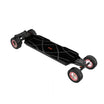If you decided to give yourself a personal transport that will make your roads more fun, eco-friendly, and faster, you must have stumbled upon the idea of choosing two popular options: the Onewheel and the electric skateboard. This article explores the transformative impact of electric skateboards and Onewheels on personal transportation, redefining our conception of mobility. By delving into the Onewheel vs Electric Skateboard debate, we'll uncover how these innovations have revolutionized the way we ride, blending technology, convenience, and eco-friendliness. Through a comparative analysis, readers will gain insights into which rideable aligns best with their lifestyle and riding preferences. Let's explore the basics of electric skateboards and Onewheels.
What is an Electric Skateboard?

An electric skateboard is a type of skateboard equipped with a battery-powered motor that propels the rider forward. It operates similarly to a traditional skateboard but with the added convenience of motorized propulsion. Riders control the speed and direction of the electric skateboard using a handheld remote or controller. MEEPO Electric skateboards come in various designs, ranging from compact cruisers to longboards, catering to different riding preferences and styles. They offer an efficient and eco-friendly mode of personal transportation, ideal for urban commuting and leisurely rides. With features like regenerative braking and customizable speed settings, electric skateboards provide a smooth and playful riding experience for users of all skill levels.
What is Onewheel?

The Onewheel is a unique electric rideable with a single-wheel design and advanced self-balancing technology, making it an innovative choice for personal transportation. Riders control the Onewheel by shifting their body weight, similar to the movements used in snowboarding or surfing. Its large tire ensures stability and traction, allowing smooth rides on various terrains, from city streets to off-road trails. Compact and portable, the Onewheel is suitable for urban commuting and outdoor adventures alike. It offers a blend of convenience, performance, and fun with features like regenerative braking and customizable riding modes.
Performance and Speed
Understanding the performance and speed is crucial when choosing personal transportation. It ensures you select a ride that matches your needs and preferences. Below, we'll discuss the performance of both the Onewheel and electric skateboard in detail to provide a clear comparison of their capabilities.
Electric Skateboard Performance

Electric skateboards, hailed for their versatility and efficiency, offer an exciting ride that meets the demands of modern urban commuters. With various models MEEPO electric skateboards cater to multiple preferences, from cruising along city streets to tackling off-road trails. One of their standout features is speed. Many electric skateboards boast impressive top speeds, ranging from 20 to staggering 40 mph, ensuring swift and efficient travel, especially for longer commutes. This speed advantage not only cuts down travel time but also adds an element of excitement to the journey. Electric skateboards excel in performance metrics such as acceleration and hill climbing capabilities. Their powerful motors provide effortless acceleration, allowing riders to navigate through traffic or conquer challenging terrain effortlessly.
Equipped with high-torque motors, they can easily tackle steep inclines, making them suitable for hilly urban landscapes or adventurous off-road trails. Another aspect where electric skateboards shine is range. Many models offer substantial battery life, enabling riders to cover considerable distances on a single charge. With ranges varying from 10 to 32 miles, electric skateboards provide ample mileage for daily commutes or leisurely rides around town without worrying about running out of power. MEEPO Electric skateboards stand out for their impressive speed, acceleration, hill-climbing capabilities, and range, making them an ideal choice for urban commuters and adventure enthusiasts.
Onewheel Performance

The Onewheel, characterized by its single-wheel design and powered by an efficient electric motor, offers a distinct riding experience. It is designed with intuitive sensors that allow for responsive control and navigation through shifts in body weight, enhancing the overall riding experience. While it's noteworthy that Onewheels do not achieve the same top speeds as electric skateboards, with their maximum speeds running from 16 mph to 25 mph between the models, they excel in agility and maneuverability. This makes them well-suited for both urban commuting and off-road adventures. Furthermore, the Onewheel's range is notably impressive, offering 8-32 miles on a single charge, which enhances its versatility. In essence, Onewheels marry innovative technology with durable construction to offer a versatile and enjoyable means of personal transportation,
Ease of Learning and Use
In terms of ease of learning and use, electric skateboards and Onewheels offer different experiences. Electric skateboards typically have a shorter learning curve, particularly for individuals with prior skateboarding experience. With handheld controllers providing intuitive control over speed and braking, beginners can quickly grasp the basics and start riding confidently. Also, Electric skateboards offer the flexibility of adjusting ride settings to accommodate different skill levels, which makes them accessible to riders of varying abilities.
On the other hand, due to their unique balancing mechanism, Onewheels require a bit more time and practice to master. Riders must develop a sense of balance and coordination to control the board effectively using subtle shifts in body weight. While this learning curve may be steeper initially, many enthusiasts find the process exciting and rewarding, as mastering a Onewheel opens up opportunities for more dynamic and thrilling riding experiences.
Ultimately, the choice between electric skateboards and Onewheels regarding ease of learning and use depends on individual preferences and prior experience. Riders seeking a straightforward and familiar riding experience may lean towards electric skateboards, while those craving a challenge and a new riding sensation may find Onewheels appealing.
Safety and Stability
When selecting personal transportation, safety and stability become central factors. MEEPO Electric skateboards offer stability through their four-wheel design, providing a familiar feeling related to traditional skateboards. However, their stability can vary depending on factors like terrain and speed. Safety features such as brakes and lights contribute to a safer riding experience. I
n contrast, Onewheels prioritize maneuverability over stability, with riders relying on their balance and body movements. While this offers a thrilling ride, it also increases the risk of falls, particularly for beginners. Onewheels lack traditional brakes, relying instead on regenerative braking and foot placement for control. And their single-wheel design presents challenges in maintaining stability, especially on uneven surfaces.
Electric skateboards have an edge when considering safety due to their more stable design and additional safety features. However, both options require caution and proper safety gear to minimize the risk of accidents. Ultimately, the choice between safety and stability depends on individual preferences and riding conditions.
Battery Life and Range
Battery life and range are also significant when evaluating personal transportation options. Electric skateboards typically offer varying battery capacities and ranges, depending on the model and brand. MEEPO electric skateboards can travel distances of up to 32 miles on a single charge, providing ample range for daily commutes or recreational rides. In contrast, Onewheels tend to have similar ranges, reaching up to 32 miles. However, this can vary based on factors like terrain, rider weight, and speed.
Both electric skateboards and Onewheels feature rechargeable batteries, with charging times ranging from a few hours to overnight. Ensuring sufficient battery life and range is essential for uninterrupted rides and overall convenience. Therefore, individuals should consider their typical usage patterns and commuting needs when assessing the battery life and range of electric skateboards and Onewheels.
While electric skateboards generally offer varying battery capacities and longer ranges compared to Onewheels, it's essential to note that specific models may vary in their performance. Some electric skateboards boast impressive battery life and range, making them suitable for extended rides and daily commutes. However, Onewheels can also provide a sufficient range for many users, depending on individual preferences and riding conditions.
Portability and Convenience
Now, let’s compare these two in different terms. When considering portability and convenience, Onewheels offer a unique balance between size and functionality. While they may be bulkier and heavier compared to electric skateboards, Onewheels often feature integrated handles or carrying straps, facilitating more accessible transportation. Their all-in-one design requires minimal setup or assembly, providing a hassle-free experience for riders on the go. In contrast, electric skateboards boast a diverse range of sizes and configurations, allowing for greater flexibility in terms of portability.
Some models feature lightweight and compact designs, making them easier to carry and transport, especially in crowded urban environments. Ultimately, the choice between electric skateboards and Onewheels depends on individual preferences regarding portability and the specific requirements of the intended usage scenario.
Price Difference
Onewheels generally have a higher price bracket than electric skateboards. Prices can vary depending on the model and its features, ranging from $750 up to $3500. In contrast, electric skateboards offer a wider range of pricing options, catering to various budgets. Entry-level electric skateboards cost a no more than $250 and offer basic functionality suitable for beginners. Higher-end electric skateboards, equipped with advanced features like more extended range and higher speeds, can go up to $1700. Overall, while Onewheels tend to be more costly upfront, electric skateboards offer a broader spectrum of prices, enabling users to select a model that meets their budget and preferences.
Conclusion: Which One Should You Choose?
When considering whether to choose a Onewheel or an electric skateboard, it's essential to evaluate your specific needs and preferences. For those seeking a unique riding experience with hands-free control and exceptional maneuverability, the Onewheel may be the ideal choice. Its ability to seamlessly transition between various terrains and its immersive feel make it suitable for riders who prioritize exploration.
On the other hand, electric skateboards offer diverse options catering to different riding styles and preferences. With higher speeds, longer battery life, and a more straightforward learning curve, electric skateboards are favored by those seeking a faster, more traditional skateboarding experience. Additionally, the availability of various models and price points makes electric skateboards accessible to a broader audience.
Ultimately, the decision between a Onewheel and an electric skateboard boils down to personal preferences and intended use. Whether you prioritize maneuverability and off-road capability or seek speed and versatility for urban commuting, both options offer unique benefits. By carefully considering your riding style, terrain preferences, and budget, you can select the option that best suits your needs and provides an enjoyable riding experience.




















